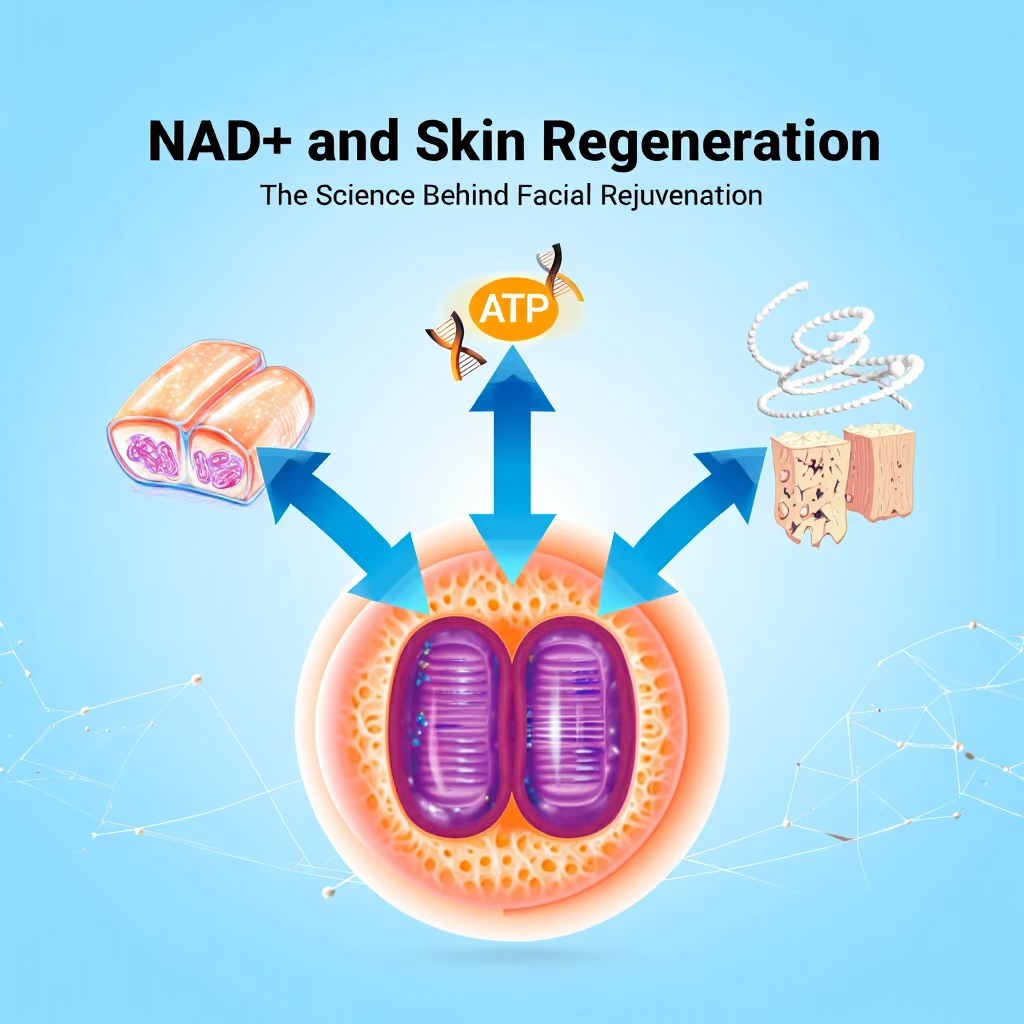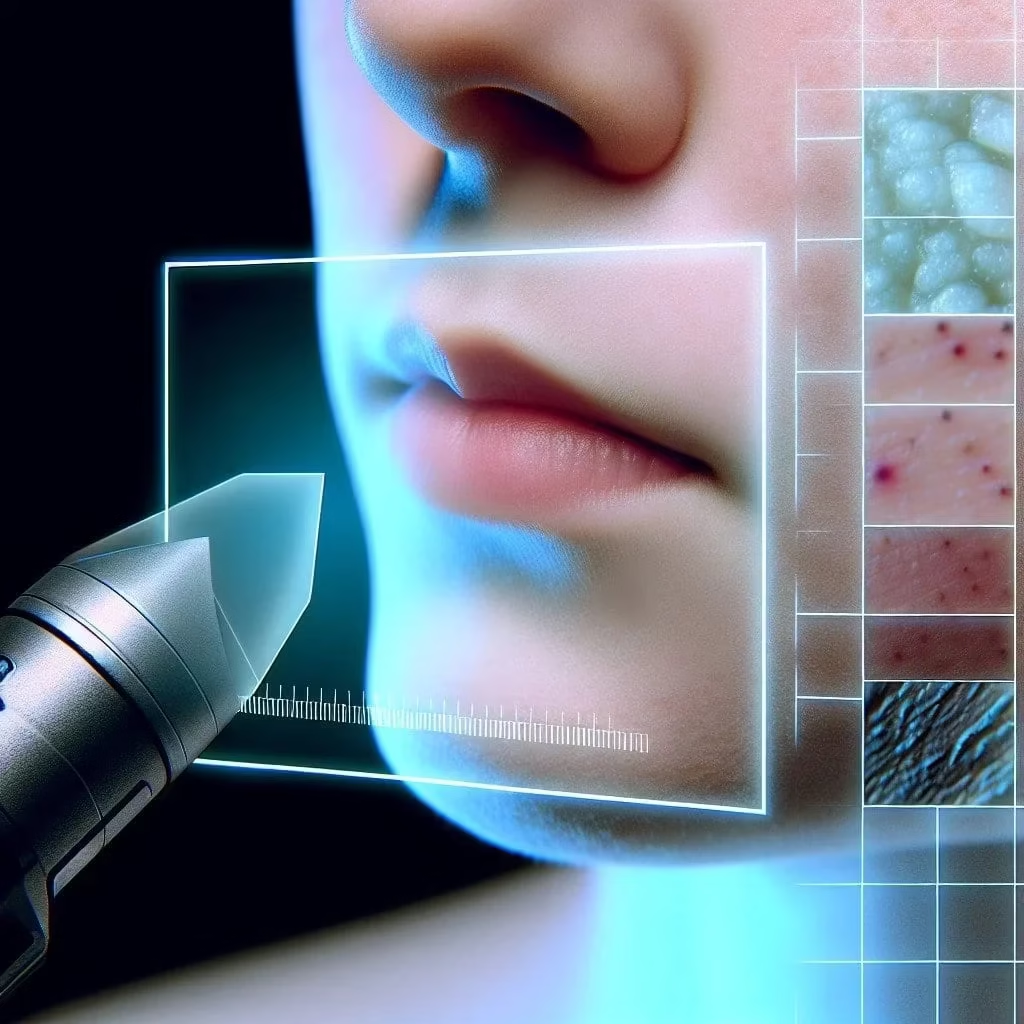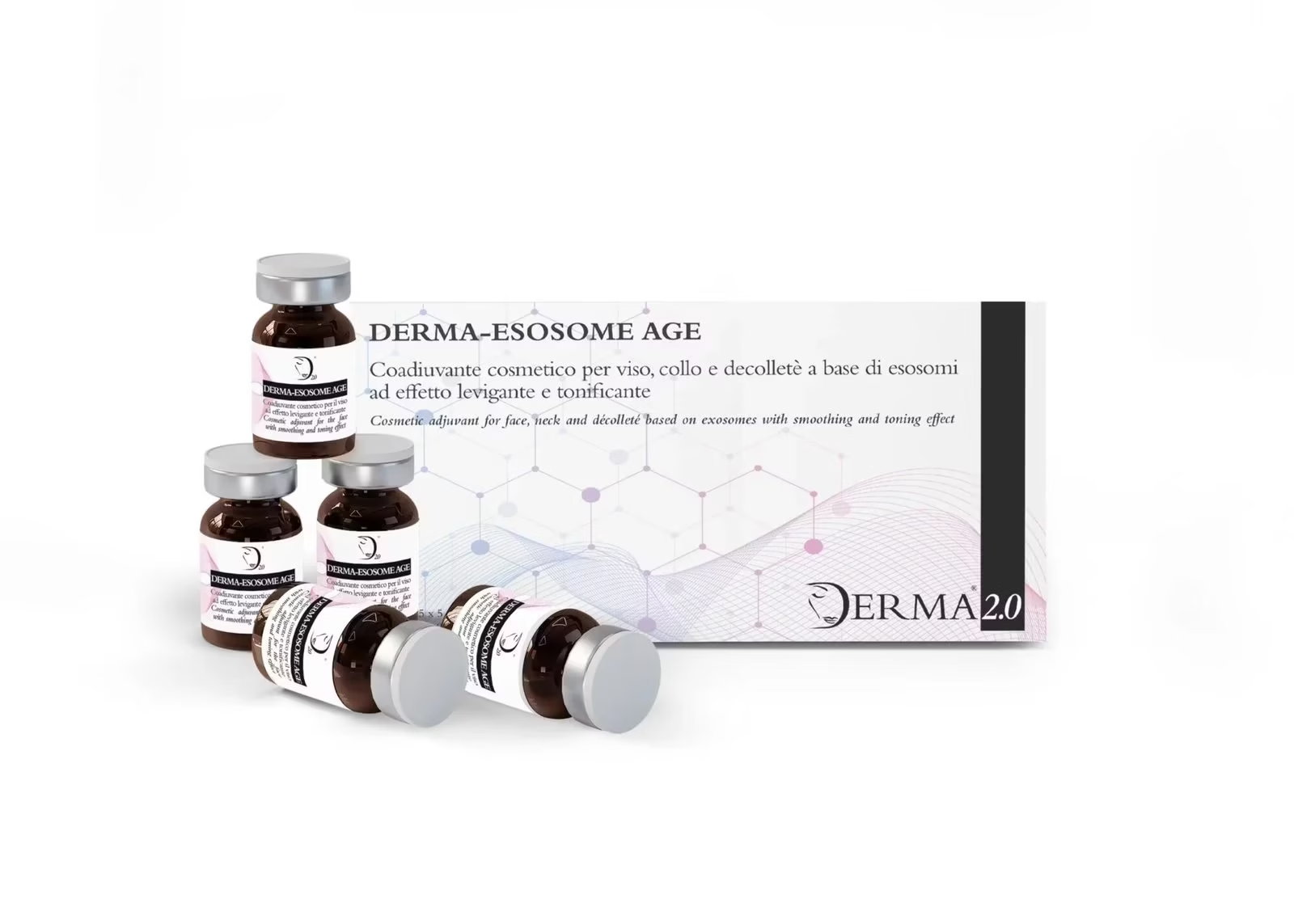
Introduction
If you are interested in regenerative medicine or the future of facial aesthetics, you might have heard about NAD+. Often called a “miracle molecule,” NAD+ has gained attention for its role in cellular energy, ageing, and tissue repair. But what does the evidence really say about NAD+ for facial aesthetics? Can it actually help rejuvenate your skin, or is it just another hype? In this blog post, we dive deep into the science behind NAD+, breaking down complex research into simple, clear insights. Whether you’re a practitioner or someone considering regenerative treatments, this guide will help you understand where NAD+ fits in — and where it doesn’t (yet).
What is NAD+ and Why Does It Matter for Skin Health?
NAD+ (nicotinamide adenine dinucleotide) is a molecule found in every living cell. It plays a critical role in producing energy (ATP) and repairing damaged DNA, both of which are essential for maintaining our skin’s youthfulness and health.
As we age, NAD+ levels naturally decline. This drop leads to:
- Slower cell regeneration
- Increased inflammation
- Decreased mitochondrial function (the “powerhouses” of our cells)
Low NAD+ is closely linked to ageing signs, such as wrinkles, sagging skin, and poor wound healing.
Boosting NAD+ could, in theory, restore youthful skin function, making it a fascinating target for regenerative facial treatments.
How Do We Boost NAD+ Levels?
Scientists have discovered that we can boost NAD+ by supplementing with precursors like:
- Nicotinamide Riboside (NR)
- Nicotinamide Mononucleotide (NMN)
These compounds are converted into NAD+ within the body, safely increasing their levels.
Human studies show promising results:
- Martens et al. (2018): A randomised controlled trial found NR supplementation increased NAD+ by 40% in older adults without major side effects.
- Airhart et al. (2017): A pilot study showed NAD+ levels rose by 60% just hours after taking NR supplements.
Key Point:
NAD+ boosting supplements appear to be safe and effective in increasing NAD+ levels within the body.
The Link Between NAD+ and Skin Regeneration
While much of the research focuses on general health, some findings strongly hint at benefits for skin rejuvenation.
How NAD+ Supports Healthier Skin:
- Energy Production: Energises skin cells to divide and repair damage.
- DNA Repair: Reduces sun-induced skin damage.
- Anti-Inflammatory Effects: Calms chronic inflammation that drives skin ageing.
- Mitochondrial Biogenesis: Revitalises “tired” skin cells by boosting mitochondrial function.
Preclinical Insights:
- Zhang et al. (2016): In a mouse study, NAD+ repletion rejuvenated stem cells and increased lifespan.
- Fang et al. (2019): Showed NAD+ restored a vital process called mitophagy, which clears damaged mitochondria and supports tissue health.
However, these studies were conducted in animals, not humans, so we must exercise caution when applying them to cosmetic treatments.
Potential Applications of NAD+ in Facial Aesthetic Treatments
If NAD+ supports regeneration inside the body, how could it be used in facial aesthetics?
Here’s how experts believe it might work:
1. Microneedling + NAD+ Boosters
Microneedling stimulates collagen production by creating tiny skin injuries. Adding NAD+ supplements could enhance repair processes, allowing the skin to heal faster and more effectively.
2. Post-Laser Recovery
After laser treatments, skin needs time to repair. NAD+ might accelerate healing, reducing downtime and improving outcomes.
3. Injectable Therapies
In the future, we might see injectable NAD+ formulations alongside fillers or PRP (platelet-rich plasma) to enhance cellular recovery.
Challenges and Limitations
While the science is exciting, it’s essential to be honest: There are still significant gaps.
- No direct clinical trials prove that NAD+ supplementation visibly improves facial skin in humans.
- Most evidence comes from lab models and animal studies.
- Long-term safety data is limited.
- We do not yet know the optimal dosage or delivery method.
In short:
NAD+ for facial aesthetics is a theoretical promise, not yet a proven reality.
What Practitioners and Patients Should Know
If you’re considering NAD+ treatments as part of aesthetic care:
- Understand that the current use is experimental.
- Always prioritise informed consent.
- Manage expectations realistically.
- Look for clinics that follow ethical and scientific best practices.
Good news:
There is little evidence of harm from short-term NAD+ supplementation when taken orally at recommended doses. Still, professional guidance is strongly advised.
How NAD+ Supports Skin Regeneration
Figure 1: Simplified NAD+ Pathway
| Process | Impact on Skin |
|---|---|
| Increased NAD+ | More cellular energy |
| Activated sirtuins | Improved DNA repair |
| Enhanced mitochondria | Stronger, healthier skin cells |
| Reduced inflammation | Fewer signs of ageing |
Adapted from Covarrubias et al., 2021.
Final Thoughts: The Future of NAD+ in Facial Aesthetics
NAD+ holds huge promise in the world of regenerative medicine. Boosting NAD+ could, one day, become a standard part of skin rejuvenation protocols. However, we’re not there yet. Until more clinical research is done, NAD+ therapies should be used cautiously and clearly presented as experimental.
In the meantime, taking steps that naturally support your body’s NAD+, like exercise, good nutrition, and sleep, remains a smart, evidence-backed strategy for healthy ageing.
References
- Rajman L, Chwalek K, Sinclair DA. Therapeutic potential of NAD+ precursors in ageing and disease. Nat Rev Drug Discov. 2018;17(7):421–436. doi:10.1038/nrd.2018.32
- Yoshino J, Baur JA, Imai S-I. NAD+ intermediates: The biology and therapeutic potential of NMN and NR. Cell Metab. 2018;27(3):513–528. doi:10.1016/j.cmet.2018.02.002
- Covarrubias AJ, Perrone R, Grozio A, Verdin E. NAD+ metabolism and its roles in cellular processes during ageing. Nat Rev Mol Cell Biol. 2021;22(2):119–141. doi:10.1038/s41580-020-00313-x
- Martens CR, Denman BA, Mazzo MR, et al. Chronic nicotinamide riboside supplementation is well-tolerated and elevates NAD+ in healthy middle-aged and older adults. Nat Commun. 2018;9(1):1286. doi:10.1038/s41467-018-03421-7
- Airhart SE, Shireman LM, Risler LJ, et al. An open-label, non-randomized study of the pharmacokinetics of the nutritional supplement nicotinamide riboside and its effects on blood NAD+ levels in healthy volunteers. PLoS One. 2017;12(12):e0186459. doi:10.1371/journal.pone.0186459
- Zhang H, Ryu D, Wu Y, et al. NAD+ repletion improves mitochondrial and stem cell function and enhances life span in mice. Science. 2016;352(6292):1436–1443. doi:10.1126/science.aaf2693
- Fang EF, Lautrup S, Hou Y, et al. NAD+ augmentation restores mitophagy and limits accelerated ageing in Werner syndrome. Nat Commun. 2019;10(1):5284. doi:10.1038/s41467-019-13172-8
- NICE Guideline NG200. Ageing Well: Promoting Healthy Ageing in Adults. National Institute for Health and Care Excellence (NICE); 2022.
NAD+ for Facial Aesthetics and Skin Rejuvenation: Expert Answers to Your Most Common Questions
1. What is NAD+, and why is it important for skin health?
NAD+ (nicotinamide adenine dinucleotide) is a vital molecule found in every cell of the human body. It plays a crucial role in cellular energy production, DNA repair, and regulating key biological processes that maintain healthy, youthful skin. As we age, NAD+ levels naturally decline, leading to reduced cellular repair, increased inflammation, and visible signs of ageing such as fine lines, loss of elasticity, and dull skin texture. By supporting mitochondrial function and activating sirtuins (proteins that promote cell survival), NAD+ helps to maintain skin integrity, resilience, and appearance. Enhancing NAD+ levels is increasingly explored as a strategy to promote regeneration and slow skin ageing.
2. Can NAD+ supplementation improve facial aesthetics?
Current scientific evidence suggests that boosting NAD+ levels may support biological processes that underlie skin regeneration, including enhanced cellular energy, improved DNA repair, and reduced inflammation. While early studies show promise in systemic health and anti-ageing, direct clinical trials specifically evaluating facial aesthetic improvements after NAD+ supplementation are limited. Preclinical research supports the potential of NAD+ to rejuvenate stem cells and repair tissue damage, which could theoretically translate to more youthful, healthier skin. However, until more targeted human studies are completed, NAD+ use in facial aesthetics remains experimental, requiring cautious optimism and careful patient counselling.
3. What forms of NAD+ therapy are being explored for skin rejuvenation?
Several approaches are being explored to leverage NAD+ for skin rejuvenation. Oral supplementation with NAD+ precursors, such as nicotinamide riboside (NR) and nicotinamide mononucleotide (NMN), has been shown to safely elevate NAD+ levels in human trials. Topical formulations of NAD+ are under development, aiming to deliver the molecule directly to the skin to promote cellular repair. Some clinics are investigating intravenous (IV) NAD+ infusions as part of broader anti-ageing protocols, although robust evidence for skin-specific benefits is lacking. Emerging strategies also consider combining NAD+ supplementation with microneedling, laser therapy, or injectable treatments to enhance regenerative outcomes, although clinical validation remains essential.
4. Is NAD+ supplementation safe, and what are the potential side effects?
Evidence from clinical studies suggests that NAD+ precursors, particularly NR and NMN, are generally well-tolerated in healthy adults over short to medium durations. Reported side effects are typically mild and may include nausea, fatigue, headache, or digestive discomfort. No serious adverse events have been associated with recommended dosages in published trials. However, long-term safety data are still limited, particularly for high-dose or continuous use. It is essential to note that the safety profile may vary depending on the delivery method (oral, topical, or intravenous) and individual patient factors. As with any therapeutic intervention, NAD+ supplementation should ideally be supervised by a qualified healthcare professional.
5. How does NAD+ decline with age, and what impact does this have on the skin?
NAD+ levels decline steadily with age, starting as early as the third decade of life. This decline contributes to decreased mitochondrial function, impaired DNA repair, increased oxidative stress, and chronic low-grade inflammation — all of which accelerate the skin ageing process. Visibly, this can manifest as wrinkles, thinning skin, reduced elasticity, slower wound healing, and a loss of youthful radiance. The skin’s ability to regenerate diminishes, making it more susceptible to environmental stressors such as UV damage and pollution. By restoring NAD+ levels, researchers aim to counteract these ageing processes at a cellular level, offering a promising pathway for regenerative skin therapies.
6. What should patients consider before using NAD+ therapies for facial aesthetics?
Patients interested in NAD+ therapies for facial aesthetics should be aware that while scientific rationale is strong, direct clinical evidence for visible skin rejuvenation remains limited. It is crucial to understand that NAD+ supplementation is currently considered an adjunctive, experimental strategy rather than a proven standalone aesthetic treatment. Patients should seek care from qualified medical professionals who can provide evidence-based advice, set realistic expectations, and ensure that any treatment plan aligns with their individual needs and health status. Transparency about the experimental nature of NAD+ therapies, potential risks, and the importance of a holistic approach to skin health (including sun protection, nutrition, and overall wellness) is vital.
Final Thoughts
The science behind NAD+ and its potential role in regenerative facial aesthetics is both compelling and evolving. While early evidence offers exciting possibilities for skin rejuvenation, it is essential to approach these emerging therapies with informed caution and professional guidance. If you are considering NAD+ as part of your facial aesthetic journey, expert consultation is key to understanding whether this innovative approach aligns with your individual goals and needs.
Take the next step towards scientifically grounded skin rejuvenation. Arrange a consultation with Dr Andy Taylor to explore how regenerative therapies could benefit your facial aesthetics.




